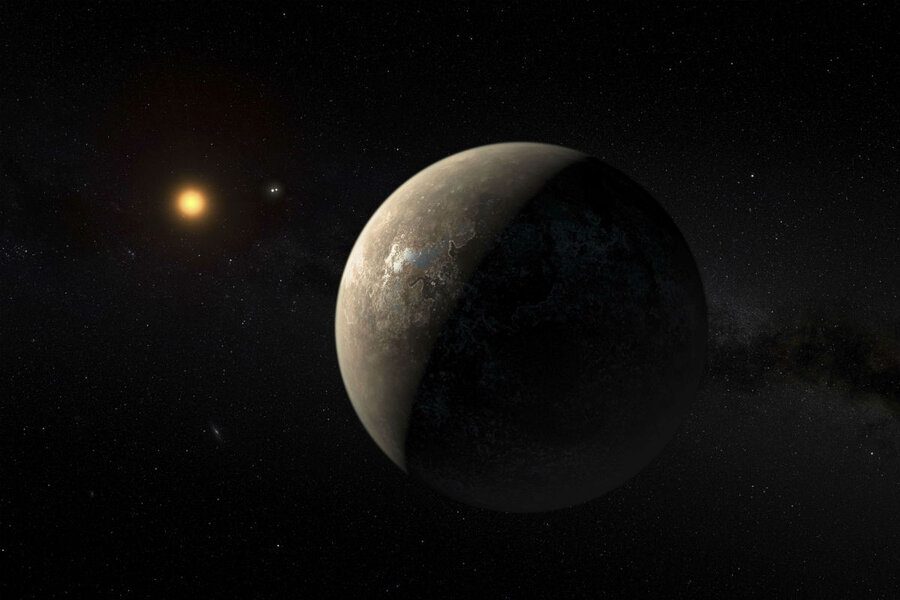Proxima Centauri's 'pale red dot' no Goldilocks planet after all
Loading...
Not too hot, not too cold, and not too baked by high energy X-ray and ultraviolet "superflares." When it comes to finding just the right place for life, it seems like we haven't been picky enough.
As such, we may have been too hopeful in thinking there was a habitable exoplanet in the solar system next door. The likelihood that red dwarf stars such as our neighbor Proxima Centauri could host planets with life has long been a hotly debated topic. But a new NASA paper says those odds are vanishing indeed.
These small, cool, long-lived stars are paradoxically more active than our sun, but some had suggested a sliver of a habitable zone could exist at just the right time under just the right conditions. This new paper slams that door shut, showing that even relatively quiet dwarfs eject enough planet-frying radiation to strip off atmosphere-forming oxygen in the astronomical blink of an eye.
Red dwarfs have been a tantalizing target for planet hunters because they're everywhere, accounting for 20 of the 30 nearest stars to Earth, and up to three quarters of the stars in the Milky Way. The debate heated up even further last summer when scientists announced the discovery of Proxima b, an Earth-sized rocky planet orbiting Proxima Centauri, one of the three stars in the Alpha Centauri system. The question was, how big was the red-dwarf habitable zone – i.e., the "Goldilocks zone" – and could Proxima b fall within it?
The nickname "Goldilocks zone" refers to the range around a star where any orbiting planets could theoretically have liquid water on their surface, due to typical temperatures that would fall somewhere between boiling and freezing. In other words, they'd be just right, like in the story of "Goldilocks and the Three Bears."
For chilly red dwarfs, calculations based on heat and light had suggested a narrow belt 10 to 20 times closer than Earth is to the sun might just do the trick. The range was thinner than that of sun-like stars, but red dwarfs' overwhelming numbers still made them promising candidates. Plus, the newly discovered Proxima b, fondly dubbed "the pale red dot," seemed to fall precisely in this range.
Reality, as is often the case, turns out to be more complicated. "Sometimes we use a loose terminology such as a 'habitable zone' or just a 'water zone' or 'super Earth' or 'mini-Neptune' that have no quantitative physics behind them. Our study is an attempt in that direction," lead author Vladimir Airapetian, a solar scientist at NASA's Goddard Space Flight Center, tells The Christian Science Monitor in an email.
A quick look at our solar system, where Venus, with its 864 degree Fahrenheit surface temperature, shares the Goldilocks zone with Earth, is enough to show that a star's light and heat fall far short of the whole story.
In the case of Proxima Centauri-style dwarf stars, the NASA team took a detailed look at the effects their radiation would have on any nearby planets.
Solar flares are a cause for concern on Earth, too, but the violent eruptions that send out huge blasts of radiation and stellar material are thought to be tens to hundreds of times stronger for Proxima Centauri. Plus, they may take place as frequently as once every hour and a half, according to Dr. Airapetian.
Scientists have long suspected that extreme space weather might make these dwarf stars less than hospitable, but the NASA team put numbers to those impressions, showing that even relatively "'quiet' dwarfs are more active than previously thought," he says.
Specifically, they found that high energy X-ray and ultraviolet radiation would strip the planet of life-supporting elements through a process called "ion escape", where negatively charged electrons in the upper atmosphere, knocked loose by solar radiation, draw positively charged ions out into space.
Previous research had shown that this phenomenon would apply to lighter elements such as hydrogen, but the new paper found the process is bad news for heavier elements like oxygen, too. The team suspects the same may be true of nitrogen, which makes up almost 80% of Earth's atmosphere. And, for life as we understand it to exist, an atmosphere is required.
The upshot is that even if an exoplanet like Proxima b had all the right ingredients for life, the punishing stellar activity of its host dwarf star would blow away the atmosphere in tens or hundreds of millions of years. For comparison, life took billions of years to emerge on Earth.
"We show that in most of the cases of M dwarfs [red dwarfs], habitable zones are not just narrower, but non-existent," Airapetian explains. The problem is that if there's no atmosphere, water will immediately evaporate off into space, no matter what the temperature is.
The conclusion has serious consequences for how common life may be in the galaxy.
In a press release, Airapetian underlined just how special our solar system seems to be: “As we learn more about what we need from a host star, it seems more and more that our sun is just one of those perfect parent stars, to have supported life on Earth.”
But for those hoping we aren't alone in the galaxy, or the discovery of a second home for humanity, this report isn't all bad news. Using the new, refined understanding of the "Goldilocks zone" will only help scientists focus the search, focusing on only the most promising candidates.
"These estimates are critical in our realistic assessment of promising targets for exoplanetary habitability to be observed and characterized with upcoming expensive missions, including the James Web Space Telescope," Airapetian says.






